|
By Pete Leenhouts - Port Ludlow Washington - USA
The Northwest School of Wooden Boatbuilding |
|
|
This month we welcome Pete Leenhouts as a regular columnist. Pete has enrolled in the Northwest School of Wooden Boat Building and has generously agreed to share some of his experiences there with the rest of us. |
What could an airline pilot, veterinarian, carpenter, engineer, marketing executive and a recent high school graduate, among others, have in common with a retired naval officer? I learned the answer last fall when we all enrolled in the Northwest School of Wooden Boat Building in Port Hadlock WA. In short, the answer is interest – perhaps “passion” isn’t too strong a word – for the traditions, skills and tools required to build something special.
You see, I’m the retired Navy guy, and I’m one of nearly thirty full-time students attending the school this year. Our backgrounds may be as varied as the reasons we have chosen to drop everything and attend this school, but our enthusiasm for wood and water gives us a common interest I’d like to share with Duckworks readers.
This column marks the first in what I hope to be a series of articles featuring the school, its projects, and the people who have taken that step to pursue their fascination with wooden boats. By sharing these stories. I hope to give back some of the enthusiasm and interest shared by prior Duckworks columnists who interested me in taking the series of steps that led me here to the shores of Port Townsend Bay in western Washington state.
After I transitioned from a wonderful career in the Navy to civilian life in 2004, I worked as a defense contractor for a year in the Washington DC area. While I had a great job and worked for a good company, I watched the seasons turn from an office window. I couldn’t help but think about what I really wanted to do – get out on the water in wooden boats I’d built myself.
This wasn’t just some midlife fling – I’d thought long and hard about my post-Navy career for years in the evenings during my final two tours in the Pentagon. There are a variety of good schools out there, but based on my research, the one that seemed to be the best fit for me and what I wanted to achieve was the Northwest School of Wooden Boats – the ‘Boat School’ – in Port Hadlock Washington.
Founded 25 years ago in 1981 by Seattle area boatbuilder Robert Prothero to preserve and promote Northwest Pacific traditional wooden boatbuilding skills, the Boat School offers three year-long programs in Traditional Large Craft Construction, Traditional Small Craft Construction, and Contemporary Wooden Boatbuilding. After completing an introductory three-month basic boat building skills course, students choose their area of interest and work closely with experienced instructors and other students to learn wooden boat building from – well, from the keel on up to the completely finished boat. The school also offers shorter courses in a variety of interesting subjects – blacksmithing, sailmaking, boat design, interior boat construction, basic foundry work, and so on.
I liked the fact that all students had to go through the introductory course, I liked the way the classes could be tailored to meet the student’s interests and time constraints, and I liked the mix of age and experience in the classes. So in late September 2005 after moving cross-country from Virginia with my wife, I entered the basic boat building skills course preparatory to beginning the Contemporary boatbuilding program in January of 2006.
The basic boatbuilding skills course is designed to provide each student, no matter what their woodworking background, a common understanding of and basic skills in hand and power tools.
We learned to sharpen all of our edged hand tools (chisels, planes, spokeshaves and others) to the proverbial razor’s edge, and we learned how to use them to construct a variety of tools and projects any boatbuilder would find useful – a bevel gage, bevel board, a series of joints, a wooden mallet, a rounded spar from square stock, a dovetailed toolbox, and a long rabbet – that groove in a boat’s stem and keel into which the ends of the planks fit.
We learned to read boat plans and draw them in a different scale, and we made a detailed half model from those plans. Most importantly, we spent a solid month in teams of two lofting boats full size on the shop floor, and we participated in building a dory with our instructor. And, throughout the entire three months, we constructed a boat on the blackboard in the classroom each morning with the school’s lead instructor, an exercise which introduced many to the terminology and thought process used to construct a variety of traditionally-built boats.
It was a good introduction to the basics for a large number of students of all ages, from 18 to over 60, ranging from one or two skilled students through a few who had some experience building boats and other things of wood to the larger number who were new to both woodworking and boats but who, like all of us, had heard the call (there just isn’t any other way to put it).
Now, boat building has begun in earnest.
The Traditional Large Craft Class under the guidance of instructor Richard Wilmore is lofting and building the molds and backbone for a 36 foot power sailor designed by Port Townsend WA designer Carl Chamberlin. The class began this boat after helping instructor Ray Speck finish a 30-foot traditionally-built Swedish ‘kostboat’ (coastboat), or “kog”, built as a day-sailor to much the same design as noted marine artist William Gilkerson’s boat “Elle”.
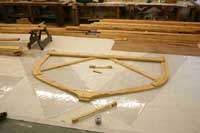 |
A mold for the motor sailor being built over the lofting
(click images for larger views) |
|
| The kostboat is ready to be rigged |

|
|
The Traditional Small Boat Class under the guidance of instructor Tim Lee is lofting an 18-foot sloop to Canadian designer Paul Gartside’s plans after finishing three boats - a small One-Day skiff, a 12-foot fishing skiff built to noted Seattle designer Edwin Monk’s 1930’s-era plans, and a dory, designed by Boat School instructor Richard Wilmore in 2005, built by his Basic Woodworking class of which I was a member, and launched in early January into Port Townsend Bay. This semester, they’ll also build two Sid Skiffs, designed by instructor Ray Speck.
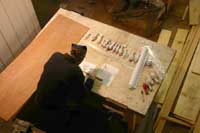 |
Lofting the Gartside sloop
|
|
| The Monk fishing skiff |
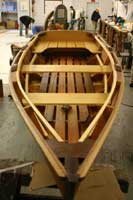
|
|
 |
Launching the Wilmore Dory
|
|
The Contemporary Boatbuilding Class, under the guidance of instructor Pat Mahon, is building the Ian Oughtred-designed plywood lapstrake Caledonia Yawl (as a sloop) for a children’s summer camp, and a cold-molded Port Townsend-class 15-foot racing dingy (a PT-15) for the Port Townsend Maritime Center’s intermediate sail racing program, the second boat in what is planned to be a new class. In addition to these two boats, the class has lofted and is building a Paul Gartside-designed 22-foot sheet plywood diesel cruiser, to his design number 74, “Jenny”.
| Ribbands mark future plank edges on the Ian Oughtred-designed Caledonia Sloop |
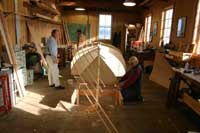
|
|
The Contemporary shop students also made minor repairs to a Pete Culler-designed Sampan, and a John Gardner-designed Chaisson Dory, both built in 2004 by Basic Woodworking Classes.
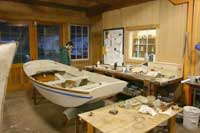 |
The Culler Sampan
|
|
It is a delight to walk in the shop each morning to find myself surrounded by experienced instructors and enthusiastic student boat builders intent on making every minute count. There’s a tremendous amount of activity in each of the three shops.
I look forward to describing and illustrating some of that activity and the boats around which it revolves in the coming months. In upcoming columns for Duckworks, I hope to report on our day-to-day progress on the Caledonia Yawl, the cold-molded PT-15 dinghy, and the diesel cruiser being built by the Contemporary Boatbuilding Class, as well as the progress made by the students in the Traditional Large and Traditional Small Craft boatbuilding programs.
If you are at all interested in boatbuilding and can spare the time for a course of any length at one of the several boatbuilding schools in the United States and elsewhere, I am certain you can find the training you need to accelerate your interest and skills. I found that course at the Northwest School of Wooden Boatbuilding in Port Hadlock WA.

|